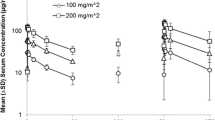Abstract
Merbarone, NSC 336628, is an investigational anticancer drug with activity against experimental animal tumors including melanoma. This paper presents results of a Phase II clinical study of merbarone in patients with biopsy proven stage IV malignant melanoma without prior chemotherapy and with no evidence of CNS involvement. Thirty-five patients with median age 58 (range 27–81), with performance status 0–2 were treated with merbarone 1000 mg/m2/day for five days by intravenous continuous infusion repeated every 3 weeks. All patients (21 males and 14 females) were evaluable for toxicity. Two patients were not evaluable for response having been removed from protocol treatment due to toxicity and received other treatment during the first course of chemotherapy. Among the evaluable patients there was one complete response in a supraclavicular lymph node lasting four months and one partial liver response lasting three months. The remaining thirty-one patients were non-reponders. Of these one had a stable disease lasting 21 months. The overall objective response rate was 6% (2/35) with a 95% confidence interval of 1%–19%. Twenty-six of the 35 patients have died. The estimated median survival of the entire group was 9 months with a 95% confidence interval of six to eleven months. Renal toxicity was dose-limiting and manifested as increasing serum creatinine (54% of patients), proteinuria (51%) and hematuria (9%). One patient experienced grade 4 creatinine increase, proteinuria and acute renal failure. Other toxicities included nausea (71%), vomiting (51%), malaise (23%), weakness (20%), alopecia (17%), diarrhea (17%), anorexia (14%), transaminase (SGOT, SGPT) increase (14%), constipation (14%), alkaline phosphatase or 5′nucleotidase increase (9%), and fever (9%). Hematologictoxicity (granulocytopenia, leukopenia, and anemia) was generally mild and infrequent (29%, only one patient had grade 4 granulocytopenia). Overall 9 patients (26%) had at least one grade 3 toxicity. We conclude that merbarone at this dose and schedule has detectable but minimal activity in the treatment of metastatic malignant melanoma and given the significant renal toxicity this schedule does not merit further evaluation in this disease.
Similar content being viewed by others
References
Brewer AD, Minatelli JA, Plowman J, Paull KD, Narayanan VL: 5-(N-phenylcarboxyamido)-2-thiobarbituric acid (NSC 336628), a novel potential antitumor agent. Biochem Pharmacol 34:2047–2050, 1985.
Driscoll JS, Melnick NR, Quinn FT, Lomax N, Davignon JP, Ing R, Abbott BJ, Congleton G, Dudeck L: Psychotropic drugs as potential antitumor agents: A selective screening study. Cancer Treat Rep 62:45–74, 1978.
Glover A, Chun HG, Kleinman LM, Cooney DA, Plowman J, Grieshaber CK, Malspeis L, Leyland-Jones B: Merbarone: An antitumor agent entering clinical trials. Invest New Drugs 5:137–143, 1987.
Cooney DA, Covey JM, Kang GJ, Dalai M, McMahon JB, Johns DG: Initial mechanistic studies with merbarone (NSC 336628). Biochem Pharmacol 34: 3395–3398, 1985.
Cooney DA, Covey JM, Dalal M, Plowman J, Kensler TW, Sinha B, Johns DG: Mechanistic studies with merbarone (NSC 336628). Proc Am Assoc Cancer Res 27:276, 1986.
Johnson RK, Hofman GA, Bartus HF, Mattem MR, Bartus JO, Mong SM, Mirabelli CK: Inhibition of Topoisomerase II by merbarone. Proc Am Assoc of Cancer Res 29:328, 1988.
Drake FH, Hofmann GA, Mong SM, Bartus JO, Hertzberg RP, Johnson RK, Mattern MR, Mirabelli CK:In vitro and intracellular inhibition of topoisomerase II by the antitumor agent merbarone. Cancer Res 49:2578–2583, 1989.
Drake FH, Hofmann GA, Bartus HF, Mattern MR, Crooke ST, Mirabelli CK: Biochemical and pharmacological properties of P170 and P180 forms of topoisomerase II. Biochemistry 28:8154–8160, 1989.
Jones JC, Stevnser T, Mattern MR, Bohr VA: Effect of specific enzyme inhibitors on replication, total genome DNA repair and on gene-specific DNA repair after UV irradiation in CHO cells. Mutation Research, DNA Repair Reports 255:155–162, 1991.
Chen M, Beck WT: Tenoposide-resistant CEM cells which express mutant DNA topoisomerase II α1 when treated with non-complex-stabilizing inhibitors of the enzyme, display no cross-resistance and reveal aberrant functions of the mutant enzyme. Cancer Res 53:5946–5953, 1993.
Kraut EH, Grever MR, Staubus AE, Malspeis L: Phase I clinical trial of merbarone (NSC 336628). Proc Am Assoc Cancer Res 29:191, 1988.
Dimaggio JJ, Warrell RP, Muindi J, Stevens YW, Lee SJ, Lowenthal DA, Haines I, Walsh TD, Balzer L, Yaldei S, Young CW: Phase I clinical and pharmacological study of merbarone. Cancer Res 50:1151–1155, 1990.
Kraut EH, Bendetti J, Balcerzak SP, Doroshow JH: Phase II trial of merbarone in soft tissue sarcoma: A Southwest Oncology Group Study. Invest New Drugs 10:347–349, 1992.
Jones DV, Ajani JA, Winn R, Daugherty KR, Levin G, Krakoff IH: A phase II study of merbarone in patients with adenocarcinoma of the pancreas. Cancer Investigation 11:667–669, 1993.
Kraut EH, Fleming T, MacDonald JS, Spiridonidis CH, Bradof JE, Baker LH: Phase II trial of merbarone in pancreatic carcinoma. A Southwest Oncology Group Study. Am J Clin Oncol (CCT) 16:327–328, 1993.
Chang AY, Kim K, Glick J, Anderson T, Karp D, Johnson D: Phase II study of taxol, merbarone and piroxantrone in stage IV non-small cell lung cancer: The Eastern Cooperative Oncology Group Results. J Nat Cancer Inst 85:388–394, 1993.
Mullane M, Holder L, Zimmer W, Braud E, Kilton L, Kucuk O, Blough R, Lad T, French S, Caroll R, Weidner L: Phase II study of merbarone in non-small cell lung cancer. Proc ASCO 12:346, 1993.
Look KY, Blessing JA, Williams L, Morris M: A Phase II trial of merbarone (NSC 336628) as salvage therapy for squamous cell carcinoma of the cervix: A Gynecologic Oncology Group Study. Proc ASCO 12:263, 1993.
Violante MR: Improved efficacy and reduced vasculitis with ultrafine dispersion formulation of merbarone. Proc Am Assoc Cancer Res 39:616, 1993.
Stratmann J: Synthesis and structure elucidation of single and multiple thionated barbituric acid derivatives (German). Pharmazie 46:103–105, 1991.
Author information
Authors and Affiliations
Rights and permissions
About this article
Cite this article
Slavik, M., Liu, P.Y., Kraut, E.H. et al. Evaluation of merbarone (NSC 336628) in disseminated malignant melanoma. Invest New Drugs 13, 143–147 (1995). https://doi.org/10.1007/BF00872863
Issue Date:
DOI: https://doi.org/10.1007/BF00872863




